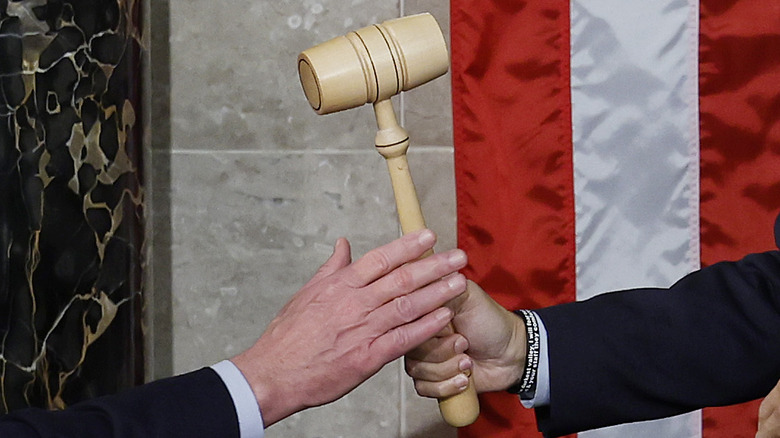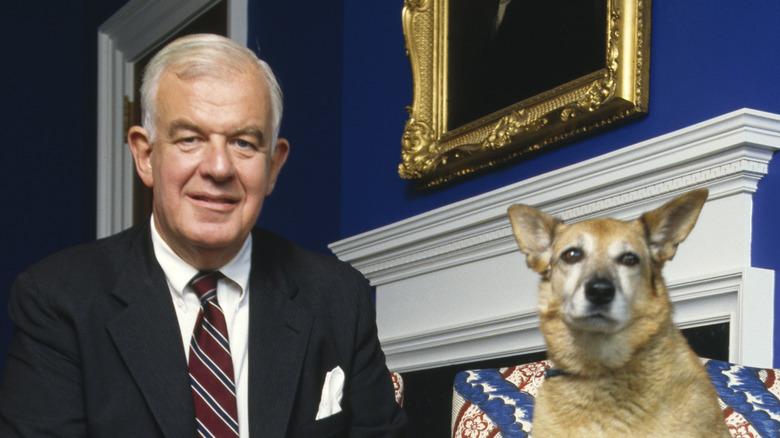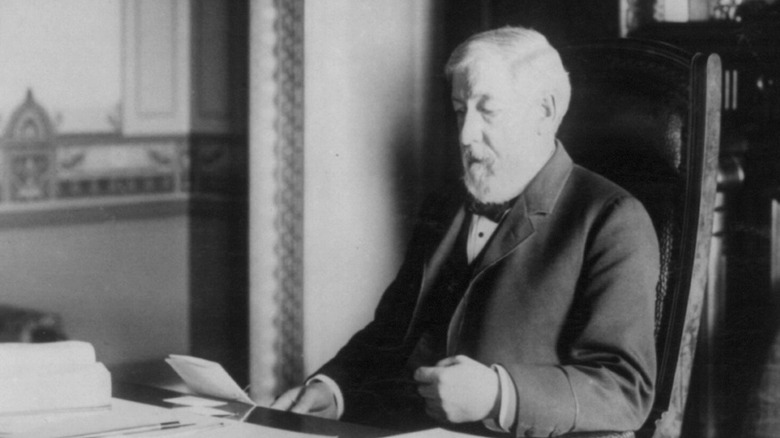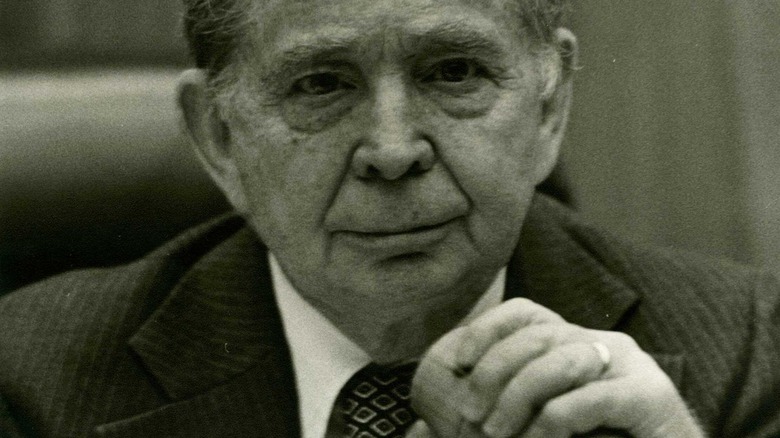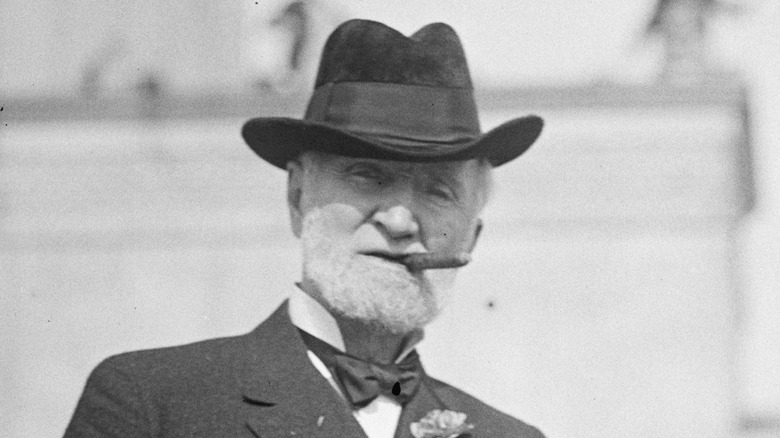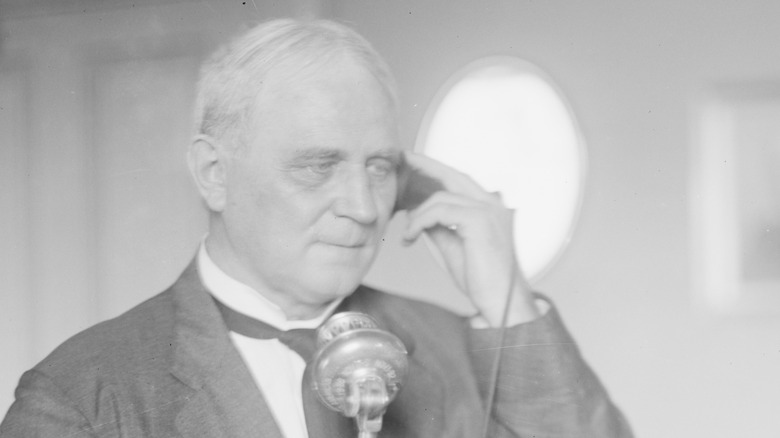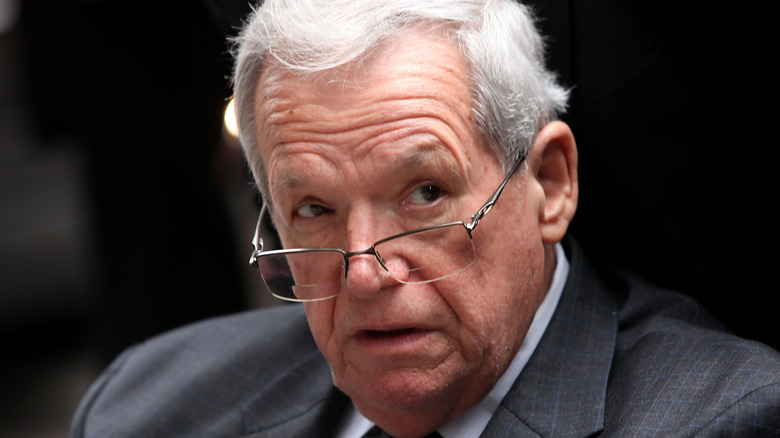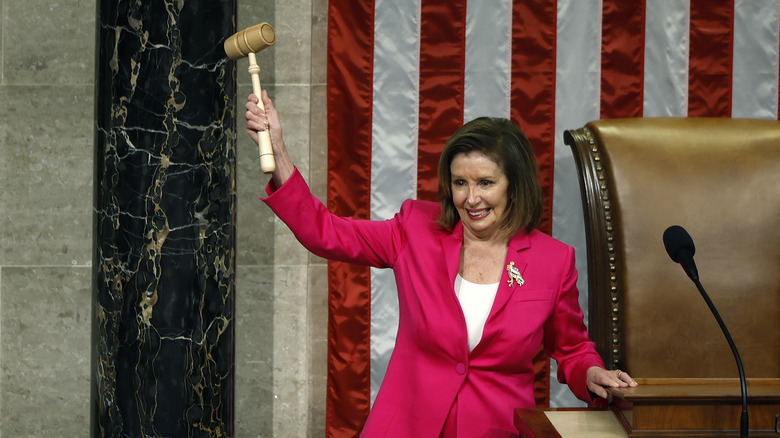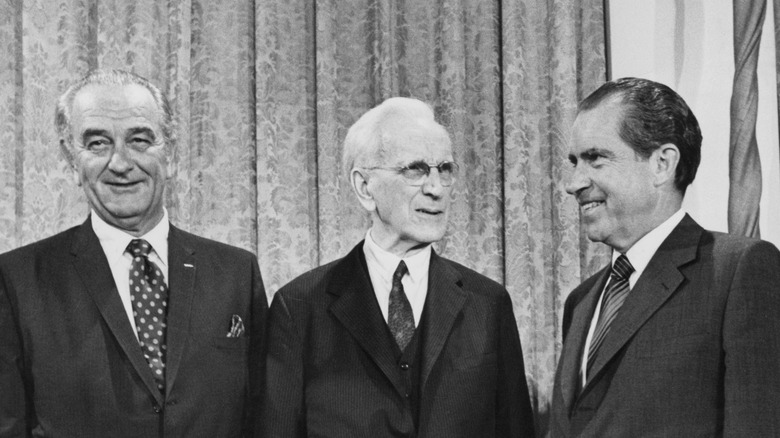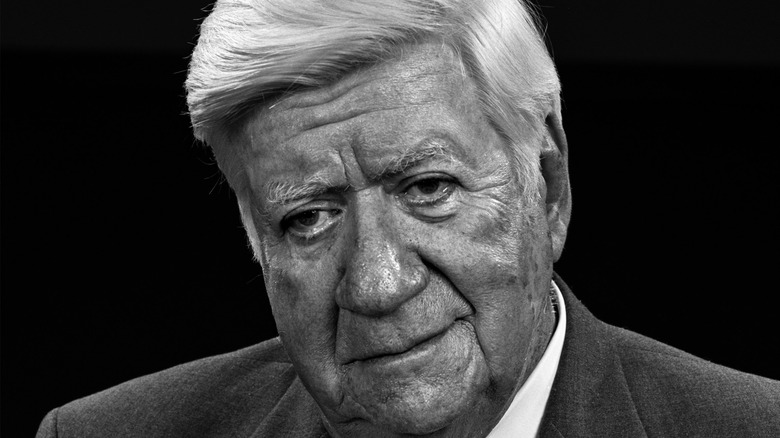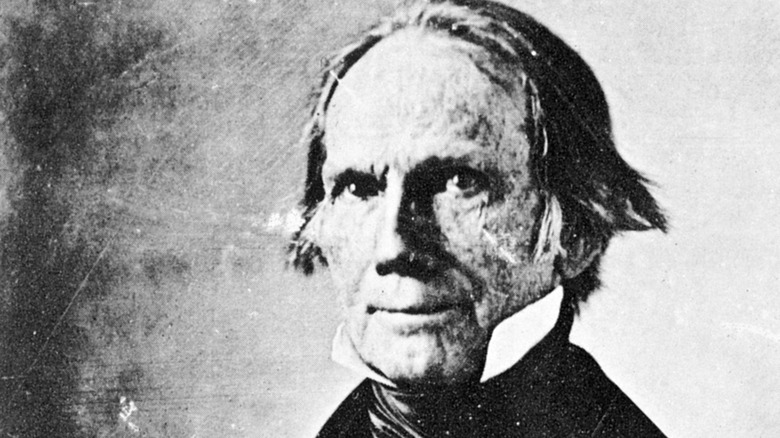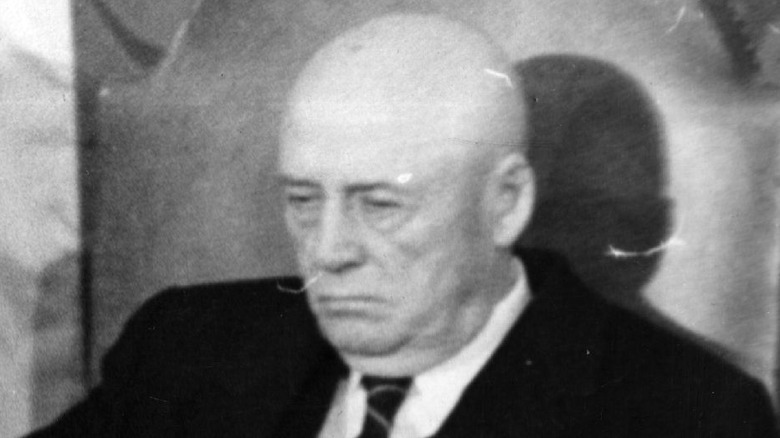The Longest Tenured Speakers Of The House In US History
The U.S. Constitution vests Congress with considerable powers and checks on the executive branch — atop which sits the president as the head of state — and the speaker of the House of Representatives may be defined as the parliamentary leader of Congress' lower chamber (per the House's History, Art, & Archives page).
The House speaker can be one of the chief figures in the U.S. government if the holder of the office wields all available authority. As explained by the BBC, the speaker sets the legislative agenda for the House each year, assigns membership to congressional committees, and oversees business on a day-to-day basis. By convention, they are also the leader of their party and responsible for advancing that party's agenda to the presidential desk. And after the vice president, the House speaker is next in line for the White House, should something happen to the president.
Fifty-four congresspeople served as speaker of the House as of the 117th Congress, according to its History, Art & Archives, with Kevin McCarthy's contentious 2023 election in the 118th making him the 55th. Some have held onto the job for a long time, as the House speakers described as follows demonstrate.
Tom Foley: 3 terms, 1989-1995
Speakers of the House can preside over glory years for their party's agenda and influence. Others may hold office in the twilight, forced to contend with shifts in the national mood and election results that stymie their preferred policies. In the case of Tom Foley of Washington state, such a political shift didn't just frustrate his party's agenda: it cost him his job.
Foley was first elected to the House in 1964, according to his obituary in The Washington Post, and from the start established himself as a man prepared to compromise. Even as he advanced in Democratic congressional leadership during the presidency of Ronald Reagan, Foley offered support to the Republican administration on key agenda items. A somewhat reluctant politician, he contrasted greatly with other leaders in the Democratic caucus, which had maintained control of the House for decades by the time he was made speaker.
That long period of control was taken advantage of by ascendant conservative voices like Newt Gingrich, who railed against Foley and the Democrats as arrogant and detached over several election cycles. Though Foley's conciliatory style helped ensure key legislation, from NAFTA to the Clean Air Act, made it through Congress, mounting dissatisfaction among voters and his own resistance to Washington's effort to impose term limits proved his undoing. He became the first House speaker since the Civil War to lose an election in the 1994 midterms.
James G. Blaine: 3 terms, 1869-1973
With a nickname like "the Magnetic Man," you might think James G. Blaine was a magician or a performer in a circus or carnival. Neither was among his jobs before becoming a politician. But Blaine did serve (per the Miller Center) as a teacher in Kentucky before uprooting to Maine, aiding in the foundation of the Republican party, and winning a seat in Congress in 1862. Within seven years, he was speaker of the House, a role he would serve for three terms.
In the often fiery atmosphere of politics immediately after the Civil War, Blaine favored a moderate course. That didn't stop him from working to win Black men the vote, though, and he was considered a well-spoken leader, according to Britannica. But the "Plumed Knight," as he was also known, had his sights on higher office. During his tenure as speaker, he was accused of profiting off his position, charges that would haunt him as he campaigned unsuccessfully for the Republican presidential nomination in 1876.
Blaine went on to win a seat in the Senate and later served as secretary of state to two presidents: James Garfield and Benjamin Harrison. In his one turn as a presidential candidate, he narrowly lost to Grover Cleveland. Ambitious to the last, he resigned from Harrison's cabinet to try and wrest the candidacy from him, but his bid and his health failed, and he died in 1893.
Carl Albert: 3 terms, 1971-1977
In the order of presidential succession, the speaker of the House stands behind the vice president. But in 1982, The Washington Post reported on plans developed for an extraordinary possibility: a Republican president's resignation and a Democratic speaker becoming chief executive. The plans were drawn up after the Watergate scandal, and the speaker who briefly stood as the immediate successor to President Richard Nixon was Carl Albert.
Albert's time in Congress was eventful even before he became speaker in 1971. A representative from Oklahoma, he was first elected in 1947 (per Britannica). Legislative battles during his time included civil rights (he initially opposed new laws, then threw his support behind the Civil Rights Act of 1964) and the Vietnam War (he supported it and offended colleagues by never repudiating it). Albert was chosen as speaker in 1971, and was therefore in a delicate position as the Watergate scandal unfolded.
When Vice President Spiro T Agnew resigned, Albert became first in line to succeed a president from another party. As the heat on Nixon increased, and with no vice president in office, plans began for Albert's possible succession. Indeed, some members of his party encouraged him to pursue the presidency and Nixon's impeachment more aggressively. Albert himself seemed prepared for the job, though the McAlester News-Capital reported that he also considered resigning to avoid the government changing party hands without an election. Nonetheless, Gerald Ford's confirmation as vice president sidestepped the issue.
Joseph Gurney Cannon: 4 terms, 1903-1911
How much power and control is vested in the speaker of the House can be in large measure determined by the personality of the speaker, and one speaker's grip was so exacting that his colleagues dubbed him "czar."
That speaker was Joseph Gurney Cannon, who first came to the House as a representative of Illinois in 1872 (per Britannica). He would serve there for decades, and along the way, he had plenty of opportunities to get a taste for leadership. The House's History, Art & Archives page mentions stints chairing the appropriations, rules, and post office expenditures committees. In 1903, when he was elected as speaker, he also held chairmanship over the rules committee, giving him near-total control of the House's agenda and mode of conduct, at the expense of the chairs.
Explaining his leadership style, "Czar Cannon" said, "Sometimes in politics one must deal with skunks, but no one should be fool enough to allow skunks to choose the weapons." The "skunks" had their day in 1910, when a bipartisan group forced Cannon to relinquish the rules chairmanship. But members kept a soft spot for the speaker on a personal level: Besides "czar," he was also known as "Uncle Joe" in the House.
Champ Clark: 4 terms, 1911-1919
Political maneuvers employed to successfully curtail a speaker of the House are not unheard of in American history. James Beauchamp Clark of Missouri, commonly known as Champ, had been in Congress since 1892 when, in 1910, he became a pivotal figure in a power play against House Speaker Joseph Gurney Cannon. As Democratic leader in the House, Clark was already opposed to Cannon, but he cooperated with breakaway Republicans to force through rules changes that curbed Cannon's hitherto unchecked power (per the House's History, Art & Archives page). The following year, Champ took Cannon's place as speaker.
Not long after getting the job, Champ managed to make a mess of treaty negotiations with Canada. Keen to see the United States expand its territory, he spoke openly on the House floor of his desire to see Canada incorporated into America in the future. His remarks, per The Knoxville Focus, so alarmed Canadians that they voted their government out of office over its treaty talks.
Champ hoped to make a quick leap from speakership to the presidency in 1912: With the Republicans divided between William Howard Taft and Theodore Roosevelt, the Democrats had good odds, and Champ won a majority of delegates at the party's convention. But a majority wasn't enough to satisfy the two-thirds required by party rules, and the support of New York and its corrupt Tammany Hall machine gave some Democrats pause. In the end, Woodrow Wilson won the nomination and subsequent election.
Dennis Hastert: 4 terms, 1999-2007
Even with his service as speaker of the House, Dennis Hastert may have remained well below most people's radar. He had no significant experience in politics when he first ran for state office in Illinois in 1980, and only became the Republican candidate when the preferred choice dropped out. Per Britannica, the same story played out in the 1986 midterms, when Hastert became a congressman. He held to the party line in the House, and had little in the way of a national profile when he was put forward as a replacement for Newt Gingrich as speaker in 1999.
Hastert's tenure, the longest to date for a member of the modern Republican party, saw him leave his mark on the chamber through the Hastert rule, requiring legislation to have majority support among the majority party's caucus before advancing to a vote. But it ended in scandal in 2006, when a House investigation determined he had neglected repeated warnings about the sexual harassment committed by Republican Mark Foley. The Republicans lost in the midterms, and Hastert resigned from Congress.
Even then, Hastert might have kept a low and relatively proper profile, but he was caught up in a more serious scandal in 2015: Questionable financial transactions led to revelations that he had sexually abused students at Yorkville High School in Illinois. Hastert served 13 months in prison and, per AP, settled related lawsuits in 2021.
If you or someone you know may be the victim of child abuse, please contact the Childhelp National Child Abuse Hotline at 1-800-4-A-Child (1-800-422-4453) or contact their live chat services.
Nancy Pelosi: 4 terms, 2007-2011; 2019-2023
In the 234-year history of the House of Representatives, only one woman has held the speakership, and she's proven to be among the most impactful lawmakers of the early 21st century. It was in such terms that President Joe Biden spoke of Nancy Pelosi when she stepped down as the House Democratic leader at the end of 2022 (per ABC News). It was a move long considered — Pelosi had contemplated giving up the reigns in 2010 and 2016. But across 19 years of leadership and two nonconsecutive stints as speaker, she left her mark on the chamber.
As a Democrat from California — San Francisco, no less — Pelosi was never going to be a favorite among rank-and-file Republicans. As speaker and minority leader, she became a favorite punching bag of conservative media for supposedly being too far to the left for the average American to swallow. As her tenure in leadership went on, Pelosi faced increasing agitation from the left flank of the Democratic party and long-shot leadership challenges (per The Guardian).
Despite the controversies, Pelosi kept firm control over her caucus. As speaker, she helped steer important environmental legislation through Congress — with the unlikely support of President George W Bush — saw that health care reform reached President Barack Obama's desk, and worked to achieve infrastructure packages on behalf of President Joe Biden. She also presided over two impeachment efforts against President Donald Trump, with whom she regularly clashed.
John W McCormack: 5 terms, 1961-1971
When John F Kennedy became the first Catholic president in 1961 (per History), he was in the company of the first Catholic speaker of the House: John W McCormack, a fellow Bay Stater from an Irish background. A loyal Democrat from his first days as a politician at the tender age of 25 (per Britannica), McCormack was a staunch supporter of Kennedy's policies and Lyndon Johnson's after him, but his career in the House stretched back to before the administration of Franklin Delano Roosevelt. And in aiding so many outsized White House personalities, the congressman attracted little fame for himself.
McCormack was first elected to Congress in 1928, and according to The Knoxville Focus, his effectiveness and loyalty moved then-Speaker Samuel Rayburn to appoint him majority leader in 1940. A genial man, McCormack enjoyed needling the Republican opposition, particularly when they opposed their own president's agenda during the Eisenhower administration, but showed no personal rancor towards political foes. His kindly demeanor didn't always serve him well in politics: When he succeeded his mentor Rayburn as speaker in 1961, he found it difficult to work with the more blustering characters in his own party who chaired various committees. There were also rivalries between his family and the Kennedys.
Despite such personality clashes, McCormack threw his weight behind civil rights and welfare legislation. But his wife's ill health and his difficulties with colleagues wore him down, and he announced his retirement from the speakership and Congress in 1970.
Tip O'Neill: 5 terms, 1977-1987
Counting total years served, Thomas P O'Neill, known colloquially as Tip, didn't have the longest tenure as speaker of the House. But he did have the longest unbroken run in that office, with an uninterrupted speakership spanning the 95th to the 99th Congress (per the House's History, Art & Archives). And he maintained a high level of personal popularity with American voters despite his long reign and frequent opposition to President Ronald Reagan.
According to Britannica, O'Neill came to politics early in life: His father served on the city council for Cambridge, Massachusetts, and the younger O'Neill fell in with New York governor Al Smith as a teen. He was elected to the state legislature in 1936, and became John F Kennedy's replacement as a representative for Massachusetts in the House in 1953. There, he came under the wing of Democratic leaders John W McCormack and Samuel Rayburn. They shepherded O'Neill up through the ranks until he became their successor as Democratic leader and House speaker (per The Washington Post).
O'Neill was a fierce advocate for liberal policies and supporting the underprivileged and downtrodden in society. He extended this to his fellow representatives, embracing various reforms to empower the rank-and-file — at the expense of the power he might have kept from his predecessors. But O'Neill's charm and backroom deals often won his colleagues over, and Republican efforts to tarnish his reputation only seemed to enhance it. Even Reagan, his greatest political foe, liked O'Neill personally.
Henry Clay: 6 terms, 1811-1814; 1815-1820; 1823-1825
According to the House's History, Art & Archives page, the speaker of the House was, in the earliest days of Congress, not a significant figure on the national stage. They might have mattered to the political party or the state the speaker hailed from, but they were more concerned with championing their home districts than federal policy. That focus changed with the speakership of Henry Clay, one of the most consequential lawmakers in American history, who held the gavel on three separate runs.
Clay, a Kentuckian, was a senator, secretary of state, and three-time presidential candidate as well as speaker. Per Britannica, he was born during the American Revolution and proved himself a natural fit for law. He was first elected to the House in 1805, hopped over to the Senate in 1806 (per Clay's House biography), and returned to his preferred chamber in 1809, with election to the speakership following two years later. Clay was quick to recognize and use his power as House speaker to steer the congressional agenda, and he was prepared to make enemies of presidents John Quincy Adams and Andrew Jackson as they clashed on policy.
Yet Clay garnered the nickname "The Great Compromiser" for his deft navigating of a fractious political environment. His middle ground on slavery postponed the Civil War but left the issue unresolved: When he died in 1852, it was with great fear for the future of the union.
Sam Rayburn: 10 terms, 1939-1947; 1949-1953; 1955-1961
As of January 2023, the longest-serving speaker of the US House of Representatives has been Samuel Rayburn of Texas. "Mr. Sam," as he was known to colleagues (per his House biography), was originally from Tennessee. His family moved to Texas early in his life, and his new state provided ample training for his future leadership of the national legislature: According to Britannica, he was speaker of the Texas House of Representatives before being elected to Congress in 1912.
Rayburn was a dedicated lawmaker who wrote or co-wrote landmark legislation contributing to Franklin Delano Roosevelt's New Deal. He also served as chair of the Interstate and Foreign Commerce Committee and proved himself a skillful navigator of inter-party politics. The speaker's gavel was first made his in 1939, and except for two brief interruptions, he would hold it until 1963.
Throughout his tenure, Rayburn championed the policies of the Democratic party without apologies. Yet he was prepared to offer a friendly hand to Republican leadership and to President Dwight Eisenhower. With the power of the speakership limited by reforms in earlier generations, he got maximum use out of the authority the office retained and used his own personal charm to keep the sometimes fractious Democratic caucus together. Rayburn was still the House speaker when his health collapsed, and he died of pancreatic cancer in 1961 (per The Desert Sun).
